Australia's Macroeconomic Policy Brief: ECON1010, Sem 1 2019 Analysis
VerifiedAdded on 2022/10/19
|8
|1693
|454
Report
AI Summary
This report provides a comprehensive macroeconomic analysis of Australia, focusing on the Consumer Price Index (CPI) and household debt. The analysis examines long-term and short-term trends in CPI, revealing changes in consumer spending across different sectors and a decreasing inflation rate. It also explores the dramatic increase and subsequent decrease in household debt between 2013 and 2019, attributing the changes to lending practices and government regulations. The policy brief section then addresses the issue of rising household debt, proposing strategies such as short-term macroeconomic policy provocations, routine assistance through a social safety net, and support to the financial sector. The report argues for strict regulations on bank lending, favoring first-time buyers, and highlights the economic rationale behind these recommendations, including the potential for a Global Financial Crisis if household debt continues to increase. The report references relevant academic literature to support its findings and recommendations.
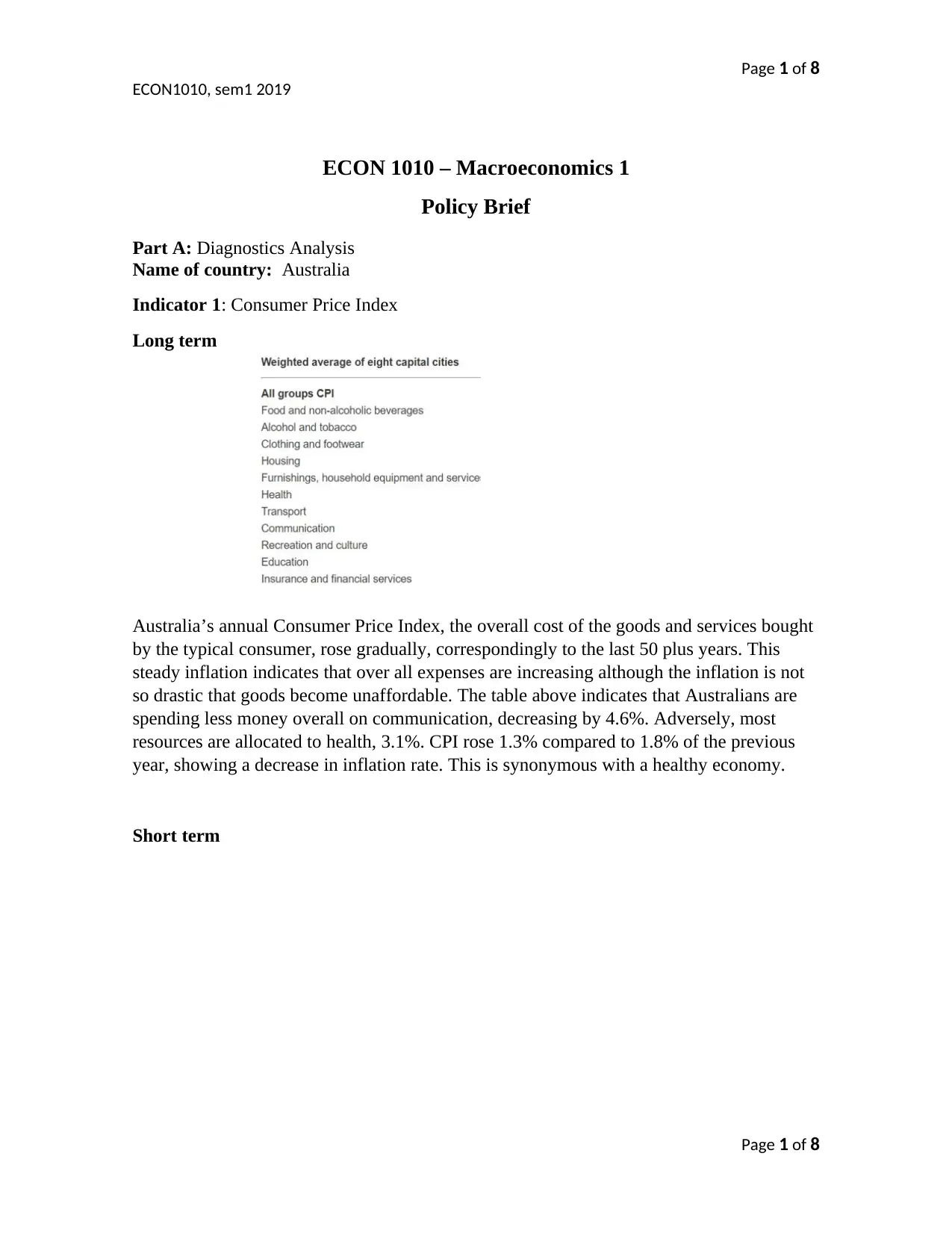
Page 1 of 8
ECON1010, sem1 2019
ECON 1010 – Macroeconomics 1
Policy Brief
Part A: Diagnostics Analysis
Name of country: Australia
Indicator 1: Consumer Price Index
Long term
Australia’s annual Consumer Price Index, the overall cost of the goods and services bought
by the typical consumer, rose gradually, correspondingly to the last 50 plus years. This
steady inflation indicates that over all expenses are increasing although the inflation is not
so drastic that goods become unaffordable. The table above indicates that Australians are
spending less money overall on communication, decreasing by 4.6%. Adversely, most
resources are allocated to health, 3.1%. CPI rose 1.3% compared to 1.8% of the previous
year, showing a decrease in inflation rate. This is synonymous with a healthy economy.
Short term
Page 1 of 8
ECON1010, sem1 2019
ECON 1010 – Macroeconomics 1
Policy Brief
Part A: Diagnostics Analysis
Name of country: Australia
Indicator 1: Consumer Price Index
Long term
Australia’s annual Consumer Price Index, the overall cost of the goods and services bought
by the typical consumer, rose gradually, correspondingly to the last 50 plus years. This
steady inflation indicates that over all expenses are increasing although the inflation is not
so drastic that goods become unaffordable. The table above indicates that Australians are
spending less money overall on communication, decreasing by 4.6%. Adversely, most
resources are allocated to health, 3.1%. CPI rose 1.3% compared to 1.8% of the previous
year, showing a decrease in inflation rate. This is synonymous with a healthy economy.
Short term
Page 1 of 8
Paraphrase This Document
Need a fresh take? Get an instant paraphrase of this document with our AI Paraphraser
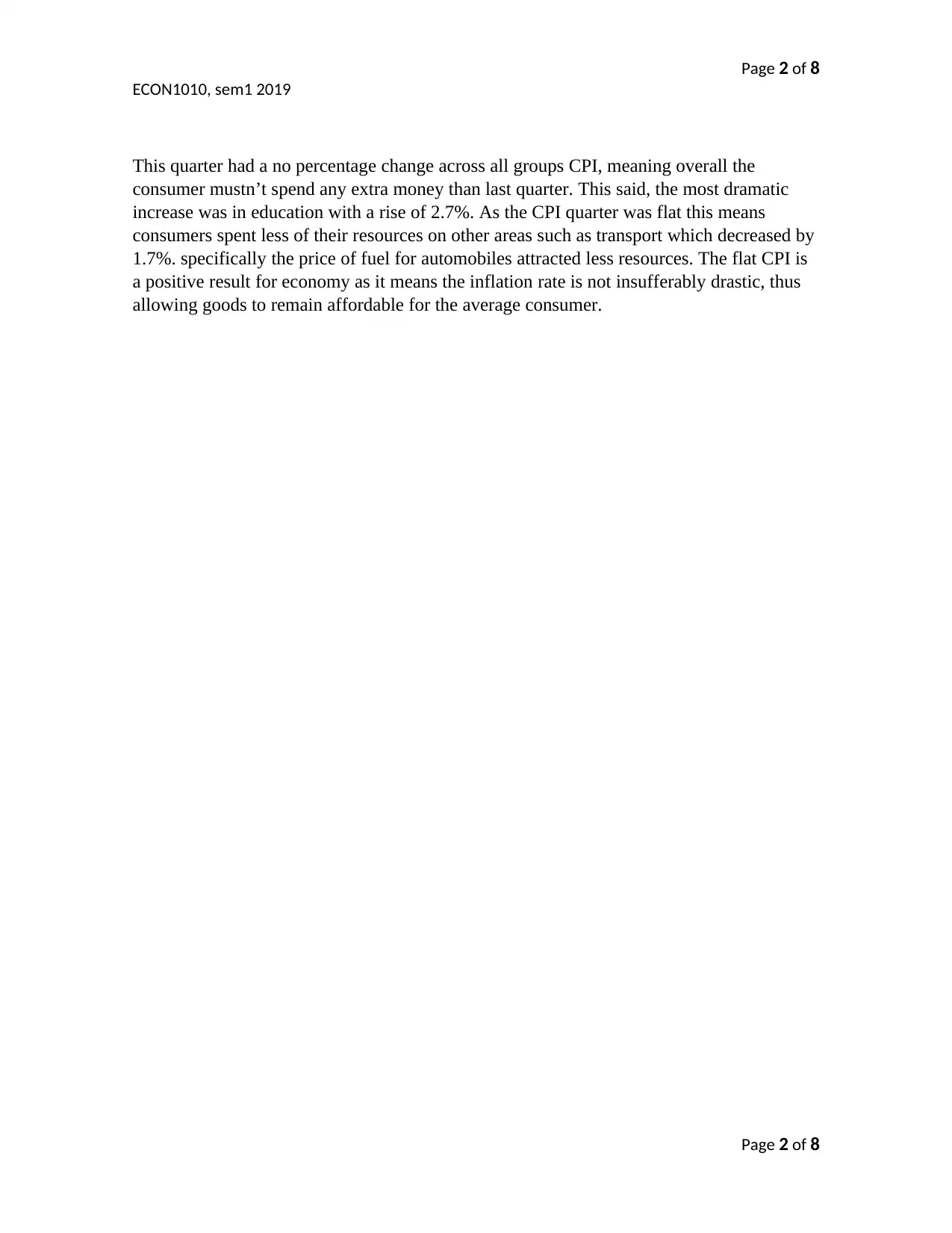
Page 2 of 8
ECON1010, sem1 2019
This quarter had a no percentage change across all groups CPI, meaning overall the
consumer mustn’t spend any extra money than last quarter. This said, the most dramatic
increase was in education with a rise of 2.7%. As the CPI quarter was flat this means
consumers spent less of their resources on other areas such as transport which decreased by
1.7%. specifically the price of fuel for automobiles attracted less resources. The flat CPI is
a positive result for economy as it means the inflation rate is not insufferably drastic, thus
allowing goods to remain affordable for the average consumer.
Page 2 of 8
ECON1010, sem1 2019
This quarter had a no percentage change across all groups CPI, meaning overall the
consumer mustn’t spend any extra money than last quarter. This said, the most dramatic
increase was in education with a rise of 2.7%. As the CPI quarter was flat this means
consumers spent less of their resources on other areas such as transport which decreased by
1.7%. specifically the price of fuel for automobiles attracted less resources. The flat CPI is
a positive result for economy as it means the inflation rate is not insufferably drastic, thus
allowing goods to remain affordable for the average consumer.
Page 2 of 8
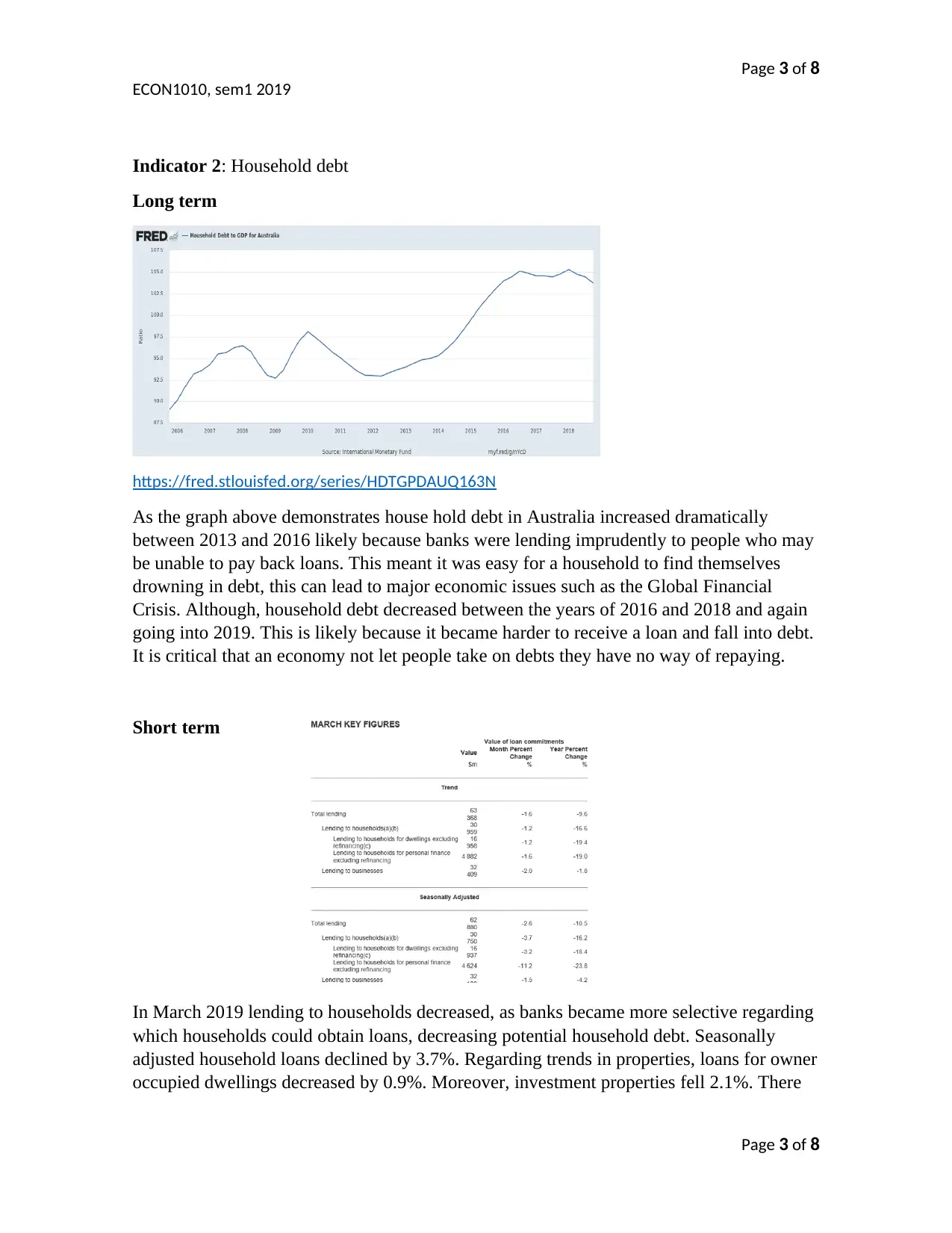
Page 3 of 8
ECON1010, sem1 2019
Indicator 2: Household debt
Long term
https://fred.stlouisfed.org/series/HDTGPDAUQ163N
As the graph above demonstrates house hold debt in Australia increased dramatically
between 2013 and 2016 likely because banks were lending imprudently to people who may
be unable to pay back loans. This meant it was easy for a household to find themselves
drowning in debt, this can lead to major economic issues such as the Global Financial
Crisis. Although, household debt decreased between the years of 2016 and 2018 and again
going into 2019. This is likely because it became harder to receive a loan and fall into debt.
It is critical that an economy not let people take on debts they have no way of repaying.
Short term
In March 2019 lending to households decreased, as banks became more selective regarding
which households could obtain loans, decreasing potential household debt. Seasonally
adjusted household loans declined by 3.7%. Regarding trends in properties, loans for owner
occupied dwellings decreased by 0.9%. Moreover, investment properties fell 2.1%. There
Page 3 of 8
ECON1010, sem1 2019
Indicator 2: Household debt
Long term
https://fred.stlouisfed.org/series/HDTGPDAUQ163N
As the graph above demonstrates house hold debt in Australia increased dramatically
between 2013 and 2016 likely because banks were lending imprudently to people who may
be unable to pay back loans. This meant it was easy for a household to find themselves
drowning in debt, this can lead to major economic issues such as the Global Financial
Crisis. Although, household debt decreased between the years of 2016 and 2018 and again
going into 2019. This is likely because it became harder to receive a loan and fall into debt.
It is critical that an economy not let people take on debts they have no way of repaying.
Short term
In March 2019 lending to households decreased, as banks became more selective regarding
which households could obtain loans, decreasing potential household debt. Seasonally
adjusted household loans declined by 3.7%. Regarding trends in properties, loans for owner
occupied dwellings decreased by 0.9%. Moreover, investment properties fell 2.1%. There
Page 3 of 8
⊘ This is a preview!⊘
Do you want full access?
Subscribe today to unlock all pages.

Trusted by 1+ million students worldwide

Page 4 of 8
ECON1010, sem1 2019
was a greater decrease in loans given to non-first time buyers, favoring people looking to
break into the market. This supports the economy as banks are less likely to collapse and
consumers can spend their resources on other goods, thus feeding the economy.
Max. of two pages for Part A (anything more than 2 pages will not be assessed)
End of Part A
Page 4 of 8
ECON1010, sem1 2019
was a greater decrease in loans given to non-first time buyers, favoring people looking to
break into the market. This supports the economy as banks are less likely to collapse and
consumers can spend their resources on other goods, thus feeding the economy.
Max. of two pages for Part A (anything more than 2 pages will not be assessed)
End of Part A
Page 4 of 8
Paraphrase This Document
Need a fresh take? Get an instant paraphrase of this document with our AI Paraphraser
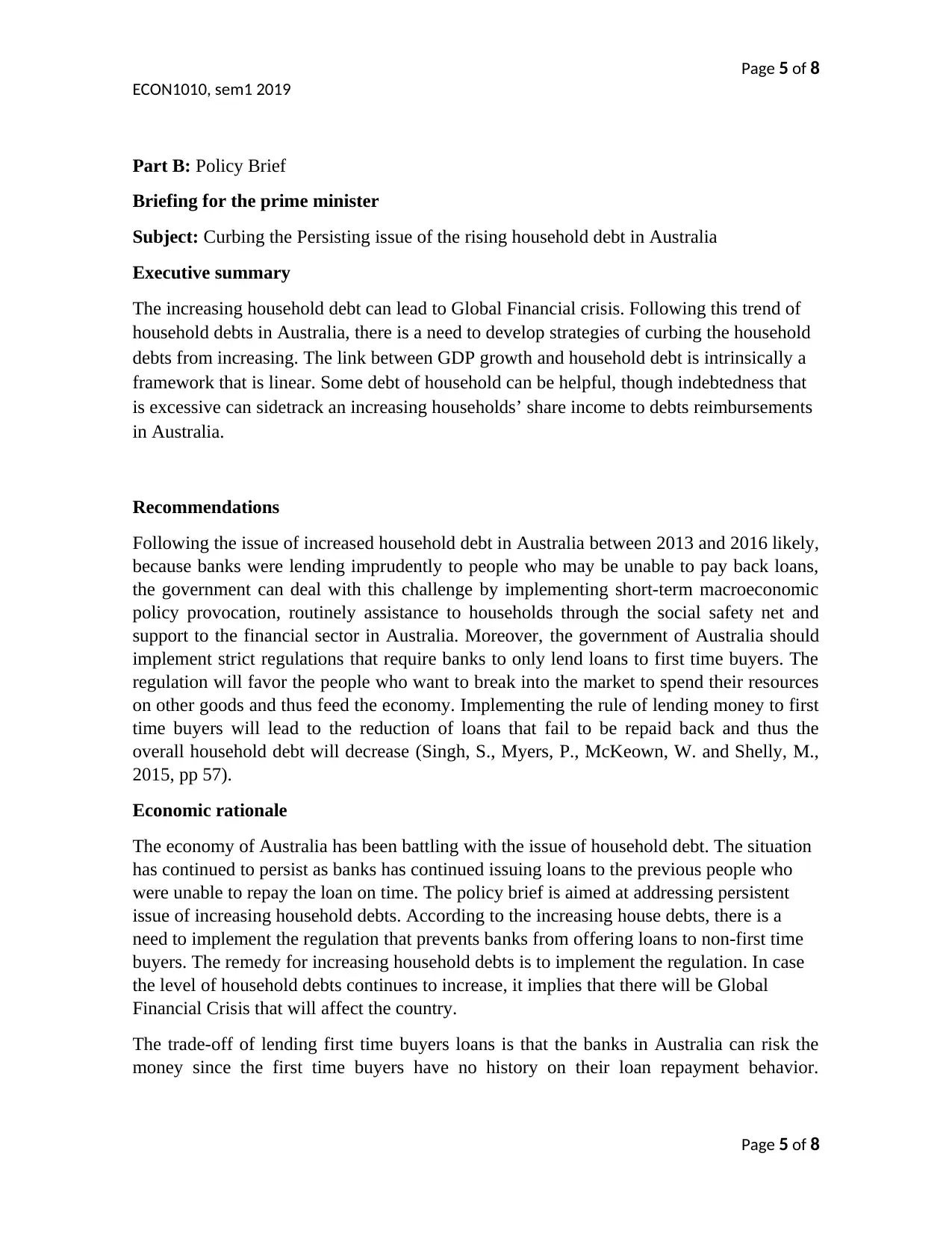
Page 5 of 8
ECON1010, sem1 2019
Part B: Policy Brief
Briefing for the prime minister
Subject: Curbing the Persisting issue of the rising household debt in Australia
Executive summary
The increasing household debt can lead to Global Financial crisis. Following this trend of
household debts in Australia, there is a need to develop strategies of curbing the household
debts from increasing. The link between GDP growth and household debt is intrinsically a
framework that is linear. Some debt of household can be helpful, though indebtedness that
is excessive can sidetrack an increasing households’ share income to debts reimbursements
in Australia.
Recommendations
Following the issue of increased household debt in Australia between 2013 and 2016 likely,
because banks were lending imprudently to people who may be unable to pay back loans,
the government can deal with this challenge by implementing short-term macroeconomic
policy provocation, routinely assistance to households through the social safety net and
support to the financial sector in Australia. Moreover, the government of Australia should
implement strict regulations that require banks to only lend loans to first time buyers. The
regulation will favor the people who want to break into the market to spend their resources
on other goods and thus feed the economy. Implementing the rule of lending money to first
time buyers will lead to the reduction of loans that fail to be repaid back and thus the
overall household debt will decrease (Singh, S., Myers, P., McKeown, W. and Shelly, M.,
2015, pp 57).
Economic rationale
The economy of Australia has been battling with the issue of household debt. The situation
has continued to persist as banks has continued issuing loans to the previous people who
were unable to repay the loan on time. The policy brief is aimed at addressing persistent
issue of increasing household debts. According to the increasing house debts, there is a
need to implement the regulation that prevents banks from offering loans to non-first time
buyers. The remedy for increasing household debts is to implement the regulation. In case
the level of household debts continues to increase, it implies that there will be Global
Financial Crisis that will affect the country.
The trade-off of lending first time buyers loans is that the banks in Australia can risk the
money since the first time buyers have no history on their loan repayment behavior.
Page 5 of 8
ECON1010, sem1 2019
Part B: Policy Brief
Briefing for the prime minister
Subject: Curbing the Persisting issue of the rising household debt in Australia
Executive summary
The increasing household debt can lead to Global Financial crisis. Following this trend of
household debts in Australia, there is a need to develop strategies of curbing the household
debts from increasing. The link between GDP growth and household debt is intrinsically a
framework that is linear. Some debt of household can be helpful, though indebtedness that
is excessive can sidetrack an increasing households’ share income to debts reimbursements
in Australia.
Recommendations
Following the issue of increased household debt in Australia between 2013 and 2016 likely,
because banks were lending imprudently to people who may be unable to pay back loans,
the government can deal with this challenge by implementing short-term macroeconomic
policy provocation, routinely assistance to households through the social safety net and
support to the financial sector in Australia. Moreover, the government of Australia should
implement strict regulations that require banks to only lend loans to first time buyers. The
regulation will favor the people who want to break into the market to spend their resources
on other goods and thus feed the economy. Implementing the rule of lending money to first
time buyers will lead to the reduction of loans that fail to be repaid back and thus the
overall household debt will decrease (Singh, S., Myers, P., McKeown, W. and Shelly, M.,
2015, pp 57).
Economic rationale
The economy of Australia has been battling with the issue of household debt. The situation
has continued to persist as banks has continued issuing loans to the previous people who
were unable to repay the loan on time. The policy brief is aimed at addressing persistent
issue of increasing household debts. According to the increasing house debts, there is a
need to implement the regulation that prevents banks from offering loans to non-first time
buyers. The remedy for increasing household debts is to implement the regulation. In case
the level of household debts continues to increase, it implies that there will be Global
Financial Crisis that will affect the country.
The trade-off of lending first time buyers loans is that the banks in Australia can risk the
money since the first time buyers have no history on their loan repayment behavior.
Page 5 of 8
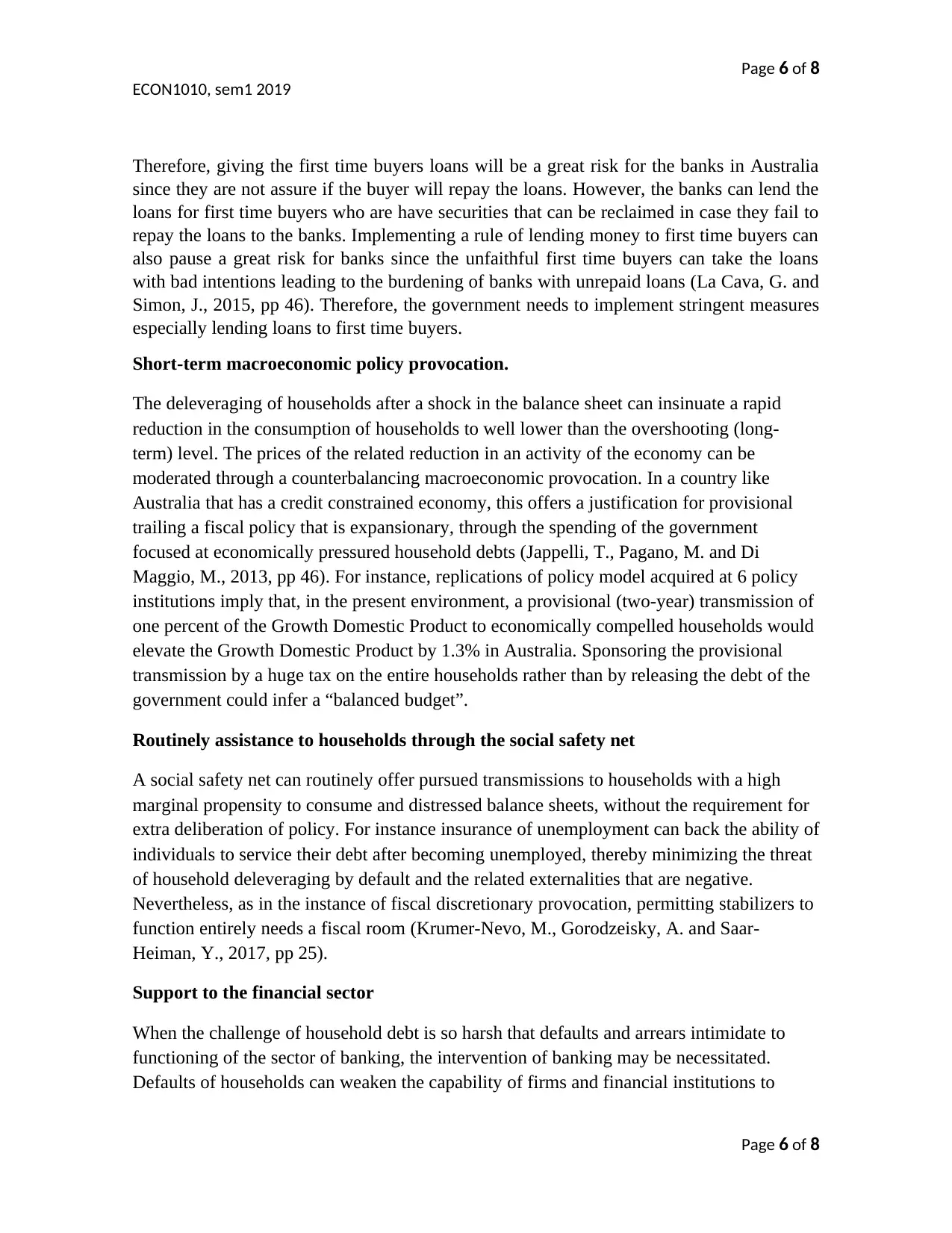
Page 6 of 8
ECON1010, sem1 2019
Therefore, giving the first time buyers loans will be a great risk for the banks in Australia
since they are not assure if the buyer will repay the loans. However, the banks can lend the
loans for first time buyers who are have securities that can be reclaimed in case they fail to
repay the loans to the banks. Implementing a rule of lending money to first time buyers can
also pause a great risk for banks since the unfaithful first time buyers can take the loans
with bad intentions leading to the burdening of banks with unrepaid loans (La Cava, G. and
Simon, J., 2015, pp 46). Therefore, the government needs to implement stringent measures
especially lending loans to first time buyers.
Short-term macroeconomic policy provocation.
The deleveraging of households after a shock in the balance sheet can insinuate a rapid
reduction in the consumption of households to well lower than the overshooting (long-
term) level. The prices of the related reduction in an activity of the economy can be
moderated through a counterbalancing macroeconomic provocation. In a country like
Australia that has a credit constrained economy, this offers a justification for provisional
trailing a fiscal policy that is expansionary, through the spending of the government
focused at economically pressured household debts (Jappelli, T., Pagano, M. and Di
Maggio, M., 2013, pp 46). For instance, replications of policy model acquired at 6 policy
institutions imply that, in the present environment, a provisional (two-year) transmission of
one percent of the Growth Domestic Product to economically compelled households would
elevate the Growth Domestic Product by 1.3% in Australia. Sponsoring the provisional
transmission by a huge tax on the entire households rather than by releasing the debt of the
government could infer a “balanced budget”.
Routinely assistance to households through the social safety net
A social safety net can routinely offer pursued transmissions to households with a high
marginal propensity to consume and distressed balance sheets, without the requirement for
extra deliberation of policy. For instance insurance of unemployment can back the ability of
individuals to service their debt after becoming unemployed, thereby minimizing the threat
of household deleveraging by default and the related externalities that are negative.
Nevertheless, as in the instance of fiscal discretionary provocation, permitting stabilizers to
function entirely needs a fiscal room (Krumer-Nevo, M., Gorodzeisky, A. and Saar-
Heiman, Y., 2017, pp 25).
Support to the financial sector
When the challenge of household debt is so harsh that defaults and arrears intimidate to
functioning of the sector of banking, the intervention of banking may be necessitated.
Defaults of households can weaken the capability of firms and financial institutions to
Page 6 of 8
ECON1010, sem1 2019
Therefore, giving the first time buyers loans will be a great risk for the banks in Australia
since they are not assure if the buyer will repay the loans. However, the banks can lend the
loans for first time buyers who are have securities that can be reclaimed in case they fail to
repay the loans to the banks. Implementing a rule of lending money to first time buyers can
also pause a great risk for banks since the unfaithful first time buyers can take the loans
with bad intentions leading to the burdening of banks with unrepaid loans (La Cava, G. and
Simon, J., 2015, pp 46). Therefore, the government needs to implement stringent measures
especially lending loans to first time buyers.
Short-term macroeconomic policy provocation.
The deleveraging of households after a shock in the balance sheet can insinuate a rapid
reduction in the consumption of households to well lower than the overshooting (long-
term) level. The prices of the related reduction in an activity of the economy can be
moderated through a counterbalancing macroeconomic provocation. In a country like
Australia that has a credit constrained economy, this offers a justification for provisional
trailing a fiscal policy that is expansionary, through the spending of the government
focused at economically pressured household debts (Jappelli, T., Pagano, M. and Di
Maggio, M., 2013, pp 46). For instance, replications of policy model acquired at 6 policy
institutions imply that, in the present environment, a provisional (two-year) transmission of
one percent of the Growth Domestic Product to economically compelled households would
elevate the Growth Domestic Product by 1.3% in Australia. Sponsoring the provisional
transmission by a huge tax on the entire households rather than by releasing the debt of the
government could infer a “balanced budget”.
Routinely assistance to households through the social safety net
A social safety net can routinely offer pursued transmissions to households with a high
marginal propensity to consume and distressed balance sheets, without the requirement for
extra deliberation of policy. For instance insurance of unemployment can back the ability of
individuals to service their debt after becoming unemployed, thereby minimizing the threat
of household deleveraging by default and the related externalities that are negative.
Nevertheless, as in the instance of fiscal discretionary provocation, permitting stabilizers to
function entirely needs a fiscal room (Krumer-Nevo, M., Gorodzeisky, A. and Saar-
Heiman, Y., 2017, pp 25).
Support to the financial sector
When the challenge of household debt is so harsh that defaults and arrears intimidate to
functioning of the sector of banking, the intervention of banking may be necessitated.
Defaults of households can weaken the capability of firms and financial institutions to
Page 6 of 8
⊘ This is a preview!⊘
Do you want full access?
Subscribe today to unlock all pages.

Trusted by 1+ million students worldwide
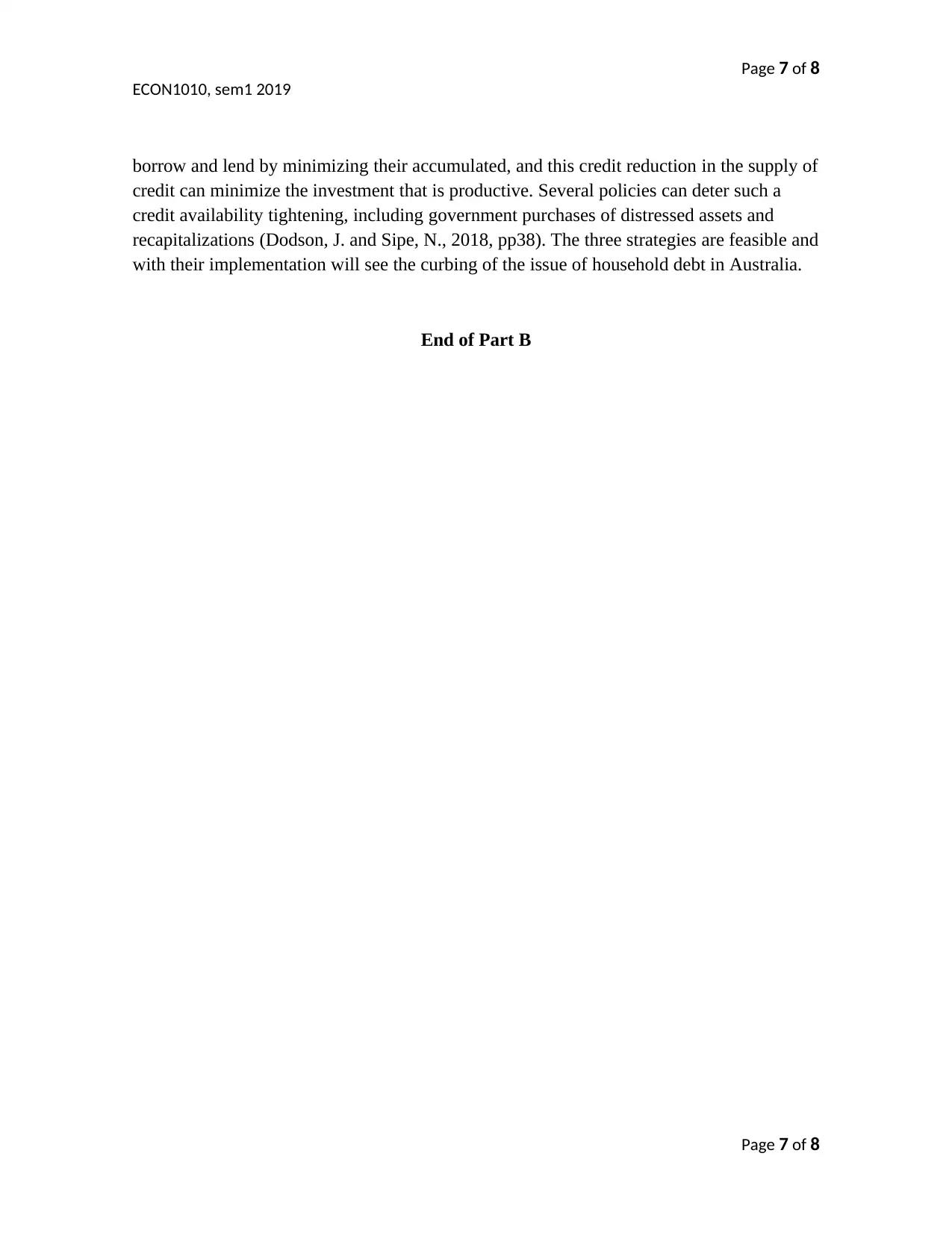
Page 7 of 8
ECON1010, sem1 2019
borrow and lend by minimizing their accumulated, and this credit reduction in the supply of
credit can minimize the investment that is productive. Several policies can deter such a
credit availability tightening, including government purchases of distressed assets and
recapitalizations (Dodson, J. and Sipe, N., 2018, pp38). The three strategies are feasible and
with their implementation will see the curbing of the issue of household debt in Australia.
End of Part B
Page 7 of 8
ECON1010, sem1 2019
borrow and lend by minimizing their accumulated, and this credit reduction in the supply of
credit can minimize the investment that is productive. Several policies can deter such a
credit availability tightening, including government purchases of distressed assets and
recapitalizations (Dodson, J. and Sipe, N., 2018, pp38). The three strategies are feasible and
with their implementation will see the curbing of the issue of household debt in Australia.
End of Part B
Page 7 of 8
Paraphrase This Document
Need a fresh take? Get an instant paraphrase of this document with our AI Paraphraser
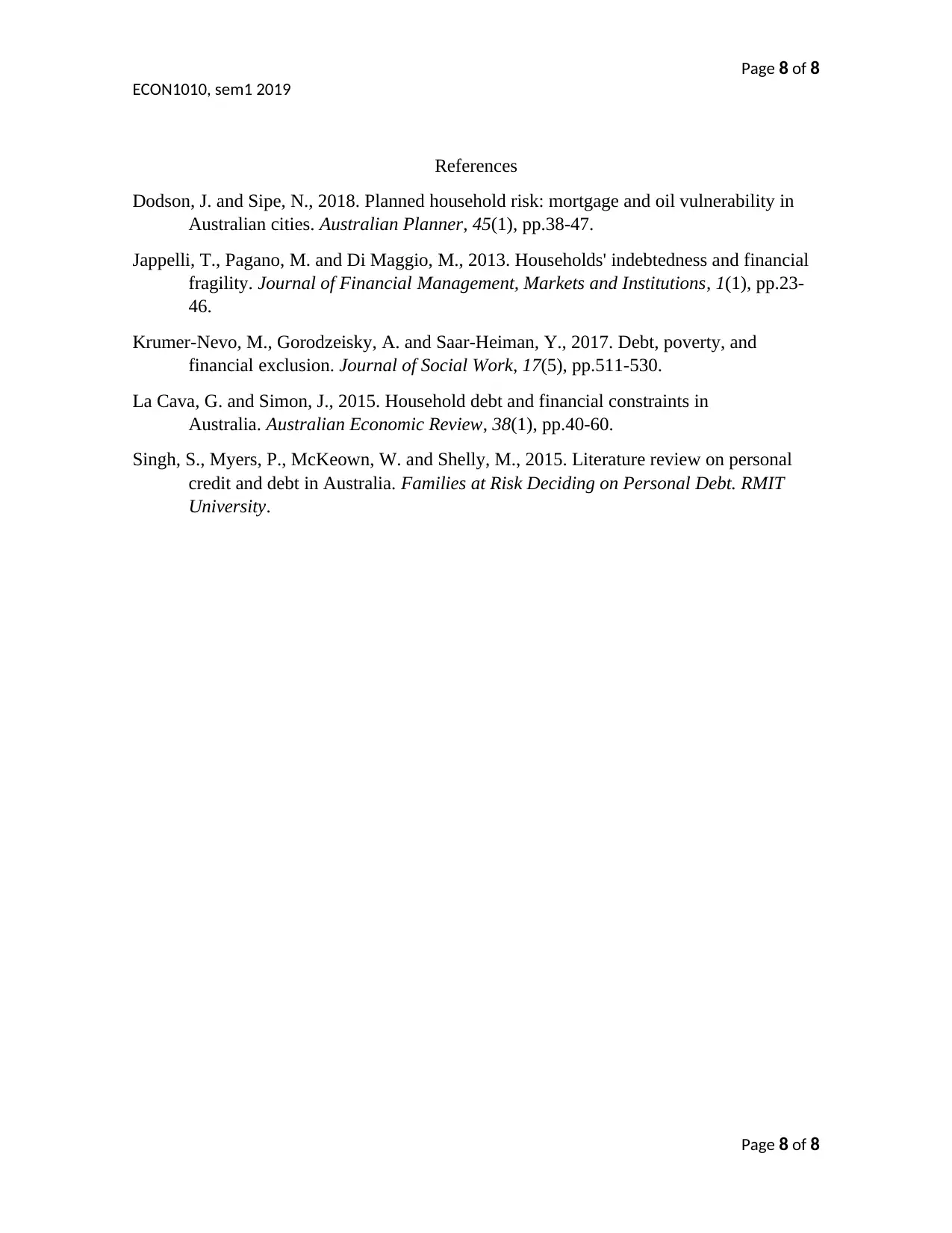
Page 8 of 8
ECON1010, sem1 2019
References
Dodson, J. and Sipe, N., 2018. Planned household risk: mortgage and oil vulnerability in
Australian cities. Australian Planner, 45(1), pp.38-47.
Jappelli, T., Pagano, M. and Di Maggio, M., 2013. Households' indebtedness and financial
fragility. Journal of Financial Management, Markets and Institutions, 1(1), pp.23-
46.
Krumer-Nevo, M., Gorodzeisky, A. and Saar-Heiman, Y., 2017. Debt, poverty, and
financial exclusion. Journal of Social Work, 17(5), pp.511-530.
La Cava, G. and Simon, J., 2015. Household debt and financial constraints in
Australia. Australian Economic Review, 38(1), pp.40-60.
Singh, S., Myers, P., McKeown, W. and Shelly, M., 2015. Literature review on personal
credit and debt in Australia. Families at Risk Deciding on Personal Debt. RMIT
University.
Page 8 of 8
ECON1010, sem1 2019
References
Dodson, J. and Sipe, N., 2018. Planned household risk: mortgage and oil vulnerability in
Australian cities. Australian Planner, 45(1), pp.38-47.
Jappelli, T., Pagano, M. and Di Maggio, M., 2013. Households' indebtedness and financial
fragility. Journal of Financial Management, Markets and Institutions, 1(1), pp.23-
46.
Krumer-Nevo, M., Gorodzeisky, A. and Saar-Heiman, Y., 2017. Debt, poverty, and
financial exclusion. Journal of Social Work, 17(5), pp.511-530.
La Cava, G. and Simon, J., 2015. Household debt and financial constraints in
Australia. Australian Economic Review, 38(1), pp.40-60.
Singh, S., Myers, P., McKeown, W. and Shelly, M., 2015. Literature review on personal
credit and debt in Australia. Families at Risk Deciding on Personal Debt. RMIT
University.
Page 8 of 8
1 out of 8
Related Documents
Your All-in-One AI-Powered Toolkit for Academic Success.
+13062052269
info@desklib.com
Available 24*7 on WhatsApp / Email
![[object Object]](/_next/static/media/star-bottom.7253800d.svg)
Unlock your academic potential
Copyright © 2020–2025 A2Z Services. All Rights Reserved. Developed and managed by ZUCOL.




